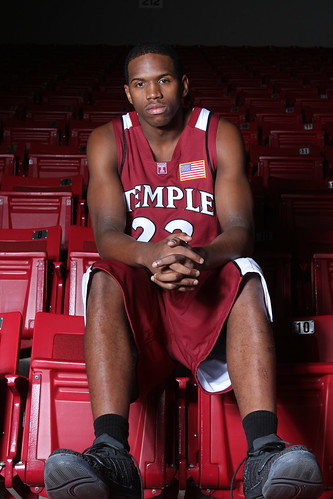A note to the fans venturing out to the Liacouras Center this upcoming basketball season: No, you are not seeing double.
There really are two 3-point lines on each side of the court.
The NCAA men’s basketball rules committee decided to move the 3-point line back a foot to 20 feet, 6 inches, in an effort to open up space on the floor. The NCAA women’s basketball rules committee decided to maintain the 19 feet, 6 inches distance, hence the two lines painted on the hardwood.
The change might be aesthetically ugly, but it could potentially make a 3-pointer more valuable.
“I think it will have an effect on the 3-point shooting percentages – that’s a given,” men’s basketball coach Fran Dunphy said. “Again, I don’t think it’s very scientific. The further back you move the 3-point line, the lower the percentage has to be.”
Since its inception during the 1986-1987 season, the average number of 3-pointers attempted per game has risen dramatically among Division I teams. In its initial season, teams averaged 9.2 3-point attempts per game. By the end of the 2006-2007 season, when the rules committee approved the change, teams were averaging 18.9 attempts.
“I think it’s in an appropriate place,” Dunphy said. “I’m just hoping that our shooting percentage will be as good as it was last year from [beyond the arc].”
Three-point shooting was one of the Owls’ strongest assets in winning the Atlantic Ten Conference. They shot 36.9 percent, their highest percentage in the last 10 years. The Owls attempted 721 treys, the most since the David Hawkins-led 2003-2004 squad tossed the same amount.
Senior guard Dionte Christmas did most of the Owls’ long-range shooting last season, firing a team-high 282 attempts and shooting at a 36.9 percent clip. Many of those shots came well beyond the line. On a few occasions, he wasn’t afraid to shoot from more than five feet beyond the arc.

“I shoot from two or three steps behind there anyway,” Christmas said. “So, I don’t think it’s going to affect me at all.”
Just to make sure, he and junior guard Ryan Brooks have been shooting between 300 and 400 3-pointers each day since practice began a few weeks ago.
Dunphy expects Brooks, whose importance shined bright as Temple made its postseason push last year, to be one of the players who relieve the pressure on Christmas.
Brooks sank 2-of-3 3-point attempts in the Owls’ A-10 clinching victory against Saint Joseph’s last March. He then followed that performance by draining 3-of-6 treys in the Owls’ loss to Michigan State in the NCAA Tournament.
Brooks said he’s not bothered by the change in the 3-point line.
“If you’re a shooter, it doesn’t really affect you,” the junior guard said. “A lot of people don’t shoot on the line anyway.”
While Brooks and Christmas are long-range shooters, the adjustment hasn’t been as easy for players who lack that range.
Senior guard Semaj Inge, a career .275 3-point shooter who attempted just 15 such shots last season, found the longer shot more difficult. However, he did pick up one advantage the lengthier shot provides – time.
“A lot of times guys are going to either be on the line or [just] behind it,” Inge said. “So, as far as when guys are running at you, you’re going to have a lot more time to get by them.”
Like most of the Owls, Inge began working on his range the moment he heard the 3-point line had been adjusted. Inge said Dunphy immediately had a new line drawn on the practice court.
So, about that double line. Is it going to be confusing at all when players pull up for a three?
“No, not really,” Inge said. “You should know where you’re at on the court anyway. Basically, when I look at it, I just try to get behind the last line.”
“When they first put the line in during early workouts over the summer,” Brooks added, “it was kind of a distraction because there’s some different colors. But we got used to it. We’re basketball players, and that’s our job – to get used to things.”
Those fans at the Liacouras Center eventually will, too.
John Kopp can be reached at john.kopp@temple.edu.


Be the first to comment